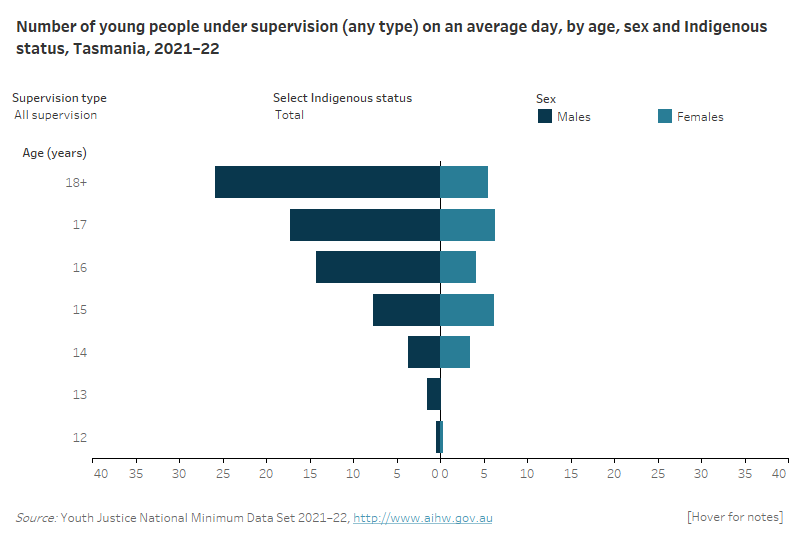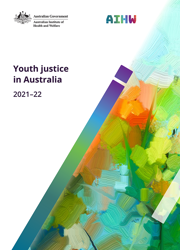Tasmania
This fact sheet summarises key findings of young people under youth justice supervision for Tasmania, including the number and rate of young people under community-based supervision and in detention. It also summarises data on young people by age, sex, Indigenous status, legal status, time under supervision and contains trends.
Impact of COVID-19 on youth justice data
This report includes data from March 2020 to June 2022, which coincides with the presence of COVID-19 in Australia. However, the direct impact of COVID-19 and related social restrictions on the number of young people under youth justice supervision is difficult to determine due to a range of factors and more research is required.
Number and rate
On an average day in 2021–22, in Tasmania:
- 97 young people aged 10 and over were under youth justice supervision (Table S137a)
- 9 in 10 (91%) were supervised in the community (Table S137b), and the rest (9%) in detention (Table S137c)
- the rate of supervision was 12 per 10,000 young people aged 10–17 (Table S138a)
- 11 per 10,000 young people aged 10–17 were under community-based supervision (Table S138b), and 1.5 per 10,000 were in detention (Table S138c).
Age and sex
On an average day in 2021–22, in Tasmania:
- 67% of those under supervision were aged 10–17, and the rest were 18 and over
- 73% of those under supervision were male
- males under supervision were most likely to be aged 18 and over, while females were most likely to be aged 17 (Table S137a).
This population pyramid shows the age, sex and Indigenous status under supervision, community-based supervision and detention for Tasmania. The age distribution of males and females was broadly similar, however males under supervision were slightly older on average than females. The largest number of males under supervision were aged 18 or older, while for females they were aged 15. Very few males and females under supervision were aged 13 and under.

Aboriginal and Torres Strait Islander young people
On an average day in 2021–22, in Tasmania:
- Indigenous young people made up 10% of those aged 10–17 in the general population, but 39% (or 25) of those of the same age under supervision (tables S137a and S144)
- A similar proportion of Indigenous young people aged 10–17 were under community-based supervision (38% or 22) and detention (44% or 4) (tables S137b and S137c)
- Indigenous young people aged 10–17 were almost 6 times as likely as non-Indigenous young people to be under supervision (47 per 10,000 compared with 8 per 10,000) (Table S138a)
- Indigenous over-representation was similar in community-based supervision (about 6 times the non-Indigenous rate) (Table S138b). Indigenous over-representation in detention could not be calculated due to small numbers.
Time under supervision
In 2021–22, in Tasmania:
- completed periods of supervision lasted a median length of 296 days (about 42 weeks) (Table S29)
- when all time spent under supervision during the year is considered, young people spent an average of 186 days (nearly 27 weeks) under supervision (Table S30).
Sentenced and unsentenced detention
On an average day in 2021–22, in Tasmania:
- 76% of young people in detention were unsentenced—that is, they were awaiting the outcome of their court matter, or had been found guilty and were awaiting sentencing
- about 3 in 10 (29%) young people in detention were serving a sentence (proportions might not sum to 100% because some young people were in sentenced and unsentenced detention on the same day) (Table S108a).
Trends to 2021–22
Over the 5 years to 2021–22, on an average day in Tasmania:
- the number of young people under supervision fell overall from 135 to 97, after peaking at 155 in 2018–19 (Table S137a). The rate decreased overall from 21 to 12 per 10,000 young people aged 10–17 (Table S12a)
- in community-based supervision, the number fell overall from 124 to 88 with a high of 144 in 2018–19 (Table S137b). The rate decreased from 19 to 11 per 10,000 (Table S45a)
- in detention, the number fell by 22% (Table S137c), and the rate decreased from 1.9 to 1.5 per 10,000 (Table S83a).
This line graph shows the number and rate of young people under supervision, community-based supervision and detention over the 5 years from 2017-18 to 2021-22 for Tasmania. It shows a decline in the rate under supervision and community-based supervision since a peak in 2018–19, while the rate for detention declined overall with a high in 2019–20.

More information
This fact sheet is part of the Youth justice in Australia 2021–22 release, which includes a report, state and territory fact sheets, and supplementary data tables.
Together, these provide comprehensive information about young people under youth justice supervision in Australia due to their involvement, or alleged involvement, in crime.
For more information see the Youth justice topic.



